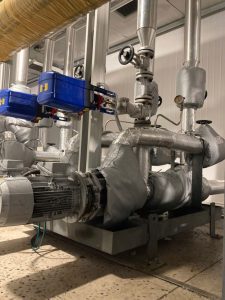Removable insulation jackets, also known as insulation blankets, are a flexible and effective thermal insulation solution for complex systems of pipes, valves, and industrial equipment. With their easy-to-remove design, these products not only help reduce energy loss and ensure operational safety but also optimize maintenance costs for businesses.
What Are Removable Insulation Jackets?
A removable insulation jacket is a system of thermal insulation materials custom-designed and tailored to the specific shape of each piece of equipment. Unlike permanent insulation methods, removable jackets can be easily taken off and reinstalled multiple times without specialized tools, making inspections and maintenance quick and cost-effective.
This is an ideal solution for components with complex shapes (like valves, joints, and turbines) or areas requiring regular maintenance, overcoming the drawbacks of traditional insulation materials.
Detailed Structure of an Industrial Insulation Jacket
A standard insulation jacket is composed of three main material layers, each playing a specific role to ensure optimal insulation performance and durability.
Layer 1: Outer Layer
- Function: Responsible for protecting the entire internal structure from environmental factors such as moisture, chemicals, oil, grease, UV rays, and mechanical impact.
- Common Materials: Silicone-coated fabric, Teflon (PTFE) fabric, PU-coated fiberglass fabric, or composite materials with excellent fire resistance, water resistance, and abrasion resistance.
Layer 2: Insulation Layer
- Function: This is the core layer that determines the product’s insulation capability, tasked with preventing heat transfer between the equipment and the environment.
- Common Materials: Ceramic Fiber, Fiberglass, E-glass, Aerogel… The thickness and type of material are selected based on the equipment’s actual operating temperature.
Layer 3: Inner Layer
- Function: In direct contact with the hot surface of the equipment, this layer must withstand high temperatures and not cause corrosion or chemical reactions with the equipment’s surface.
- Common Materials: Fiberglass fabric, silica fabric, or stainless steel mesh (Inox) for additional reinforcement in extremely high-temperature environments.
Additionally, insulation jackets come with accessories such as straps, buckles, D-rings, and heat-resistant Velcro tape to ensure the jacket is securely and snugly fastened.
5 Key Benefits of Using Removable Insulation Jackets
Investing in insulation jackets brings many practical and sustainable values to a business.
1. Save Energy, Optimize Operating Costs
By preventing heat loss, insulation jackets help the system maintain a stable temperature with lower energy consumption, thereby significantly reducing production costs.
2. Enhance Workplace Safety
Insulation jackets keep the surface temperature of equipment at a safe level, minimizing the risk of burns to engineers and operators during their work.
3. Protect and Extend Equipment Lifespan
The product helps shield equipment from harmful elements such as moisture, chemicals, and sudden temperature changes, contributing to reduced corrosion and a longer service life.
4. Flexible, Reusable, and Saves Maintenance Costs
This is the biggest advantage. Quick removal and installation shorten downtime for maintenance. Insulation jackets can be reused many times, saving costs compared to redoing permanent insulation after each repair.
5. Effective Noise Reduction
The thick layers of material also have sound-absorbing properties, helping to reduce noise emitted from equipment and pipes during operation, improving the work environment.
Common Applications in Various Industries
Thanks to their flexibility and effectiveness, insulation blankets are widely used in many locations and across various sectors:
- Piping Components: Various types of valves (globe, ball, gate), flexible joints, flanges, elbows, tees.
- Machinery and Equipment: Turbines, air compressors, heat exchangers, boilers, furnaces, plastic injection molding machines.
- Industries:
- Power plants, oil refineries, gas processing (Oil & Gas).
- Chemical, plastics, and textile manufacturing plants.
- Food and pharmaceutical processing plants.
Criteria for Choosing the Right Insulation Jacket
To ensure a return on investment, businesses should consider the following factors when ordering:
- Operating Temperature: Accurately determine the maximum surface temperature of the equipment.
- Work Environment: Is the equipment located indoors or outdoors? Will it be exposed to chemicals, oil, grease, or water?
- Size & Shape: Provide detailed drawings or measurements of the equipment to ensure a perfect fit.
- Maintenance Frequency: For locations requiring frequent removal, prioritize designs with convenient fastening systems.
- Special Requirements: Fire resistance, anti-static properties, food-grade safety standards, etc.
To receive the most optimal solution, please contact reputable suppliers for direct consultation and site surveys.
Request consultation and quotation now!Frequently Asked Questions
What temperature can an insulation jacket withstand?
Depending on the internal insulation material, jackets can be designed to withstand temperatures from low to very high, often capable of exceeding 1000°C with specialized materials like ceramic fiber or silica.
What is the average lifespan of an insulation jacket?
The lifespan of an insulation jacket depends on the quality of materials, the working environment, and the frequency of removal and installation. Typically, a high-quality product can be used for many years.
Is installing an insulation jacket difficult?
No. Insulation jackets are designed for easy user installation and removal using the included straps and fastening systems, without requiring specialized skills or complex tools.
How do removable insulation jackets compare to permanent insulation?
Removable jackets are more flexible, facilitate easy maintenance, and are reusable. Permanent insulation often has a lower initial cost for large, straight sections but becomes costly when the underlying equipment needs repairs.
Are insulation jackets waterproof and chemical-resistant?
Yes. The water and chemical resistance depends on the outer layer material. Fabrics like Silicone and Teflon (PTFE) offer excellent resistance to moisture and chemicals.










